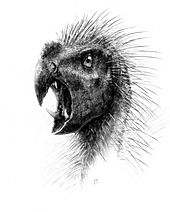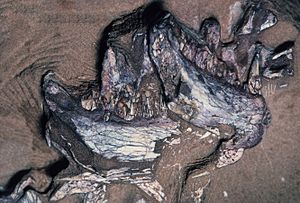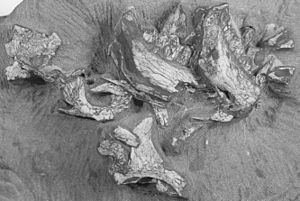Pegomastax facts for kids
Quick facts for kids PegomastaxTemporal range: Lower Jurassic 200–190 mya
|
|
|---|---|
 |
|
| Scientific classification | |
| Kingdom: | |
| Phylum: | |
| Class: | |
| Superorder: | |
| Order: | |
| Family: | |
| Genus: |
†Pegomastax
Sereno, 2012
|
Pegomastax (say "Peg-oh-MASS-tax") means "strong jaw." It was a small dinosaur that lived about 200 to 190 million years ago. Scientists found its fossils in South Africa. This dinosaur was a herbivore, meaning it ate plants. It was only about 60 centimeters (2 feet) long, which is shorter than a typical school desk!
Pegomastax belongs to a group of dinosaurs called heterodontosaurids. These dinosaurs were known for having different kinds of teeth, much like mammals do.
Discovery of Pegomastax
The main fossil of Pegomastax is a partial skull. It includes parts of the lower jaw and a bone from behind the eye. This important fossil is called a holotype (the first specimen used to describe a new species).
Scientists found this fossil in a place called Voyizane in South Africa. It was in rock layers from the Elliot Formation. These rocks are very old, dating back to the early part of the Lower Jurassic period. This was between 200 and 190 million years ago.
The fossil was first collected a long time ago, in 1966–1967. But it wasn't officially named and described until 2012. A scientist named Paul Sereno recognized how special it was in the 1980s. He later published a detailed description of it. The official name for this dinosaur is Pegomastax africana.
What Made Pegomastax Special?
Pegomastax had some unique features that made it different from other heterodontosaurids. Its lower jaw was very strong and had a short, beak-like front part.
Like most other dinosaurs in its family, Pegomastax had a large, fang-like tooth at the front of its lower jaw. This tooth looked a bit like a dog's canine tooth. Scientists think this special tooth might have been used for defense, helping the small dinosaur protect itself.
Images for kids
-
Reconstruction of jaw musculature and keratin sheathing of the beak in Heterodontosaurus
-
Map of heterodontosaurid localities in South Africa and Lesotho, Pegomastax is known from Voyizane
See also
 In Spanish: Pegomastax africana para niños
In Spanish: Pegomastax africana para niños







